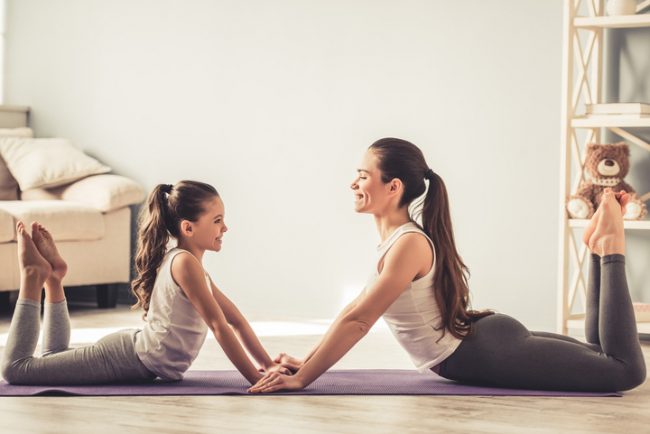The calendar has flipped to another year, a time burgeoning with excitement and inspirations, which in layman’s terms means you’re currently being bombarded with messages that you need to transform yourself into and entirely different person in the next 90 days or so. Okay, maybe not that quickly, but the overall sentiment is the same this year as it is every year: It’s time to get your act together, sooner rather than later.
Most of us set out on a well-intentioned path of New Year’s resolutions to better ourselves in one way or another. From exercising more to living life in the present to organizing our lives, our goals usually all fall under the umbrella of self improvement.
But figuring out a way to incorporate all of this personal betterment into our already overfilled schedules is often daunting, and sometimes downright discouraging. Yet, there is one simple addition to your daily routine that can help you achieve your goals regardless of what they are: Yoga.
Why practice yoga?
Whether your resolution was to tone up, calm down or get your act together, yoga is a perfect vehicle for achieving these goals. Don’t believe it? Well, the American Osteopathic Association sites the benefits of yoga as including reduction of stress, lowering of blood pressure, improved respiration and increased cardiovascular and circulatory health, and that’s in addition to the no-brainer benefits like increased strength, endurance, muscle tone and flexibility.
Physical benefits
Yoga can be modified for all ages, fitness levels, injuries, and physical abilities. The most popular styles of yoga span a variety of approaches, each offering a distinct way of practicing this ancient form of exercise and wellness, which you can choose based on your ultimate goal.
- Hatha – The most traditional form of yoga, incorporating a variety of physical postures to aide in flexibility, strength, relaxation and concentration.
- Vinyasa flow – Traditional yoga postures blended together, moving from one posture to the next with the assistance of breathing techniques as a means to a balanced body and mind.
- Bikram – Fixed form yoga practice, utilizing the same 26 postures practiced in a heated room (usually between 95-108° with 40 percent humidity) aimed at increasing strength and endurance.
Emotional and mental well-being
Because yoga includes an element of meditation, it often serves as not only an exercise practice but a coping mechanism for millions of people around the world. Harvard Medical School published an article in 2017 stating, “Available reviews of a wide range of yoga practices suggest they can reduce the impact of exaggerated stress responses and may be helpful for both anxiety and depression.”
In addition, the article sites a study from the University of Utah in which pain response was compared between three groups of subjects: one group of healthy individuals who did not practice yoga, one group with fibromyalgia and the third group who practiced yoga regularly. Unsurprisingly to the researchers, functional MRIs showed the lowest level of activity in the areas of the brain associated with pain response in the group of long time yoga practitioners.
The article concluded, “The evidence is growing that yoga practice is a relatively low-risk, high-yield approach to improving overall health.”
Healthy home is a happy home
It’s not rocket science. Taking time for yourself, reducing stress and bettering your health will affect the overall health of your entire home. Be it your ability to stay calm when your kids are melting down, the example you’ll be setting by showing your family that your health and well-being is important enough for you to work on every single day, or the simple fact that physical activity is good for you, the ripple affect of a daily yoga practice is beautiful and your entire home will benefit.
Putting it into practice
1. As with anything, the key to creating a new habit is consistency. Build your practice over the course of an entire year. Use a planner, a calendar or print out a monthly goal sheet to keep yourself on track. Set an alarm in your phone and stick to it. Also, create a reward system for each week, month, new pose you conquer. Motivation can wane sometimes and you will need that extra incentive to push through.
2. Forget joining a gym or a yoga studio. You’re not going to go anyway and it’s wasted money. Instead, use every option at your fingertips, literally. Get a book of beginner yoga poses or a yoga DVD from the library. Check if your cable or satellite company offers any yoga programs On Demand or if there is a channel dedicated to exercise (and then put that DVR to use). Download an app on your mobile device – many of them are free – and put it right on your main screen.
3. The thought of jamming an hour long yoga class into your already busy day is enough to make you throw away the idea altogether. Instead of diving in head first and setting yourself up to crash and burn, start with 5 minutes a day. You can handle that, right? What’s five minutes? If you want to do it first thing in the morning or at night before you go to bed, it doesn’t matter, either way, by the end of the first month you’ll have established yoga as part of your daily routine.
Then, add five more minutes each month. This step-up approach will allow your body and your schedule to adjust gradually. In your twelfth month you’ll be doing an hour long yoga practice every day and you will be amazed at how easy it was after all.
4. Invite your family to participate. At first they may scoff, but as your practice progresses and they see that you have established a healthy and enjoyable habit, they will want a piece of that joy, too.

